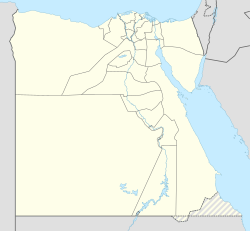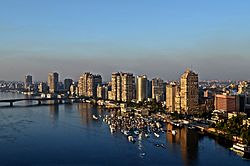Boulaq
In the world of Boulaq, there are endless aspects and facets that deserve to be explored and analyzed in depth. From its origins to its evolution today, Boulaq has left an indelible mark on the history of humanity. This article delves into the various aspects that make Boulaq a topic of universal interest, addressing its social, cultural, economic and political impacts. Along the following lines, we will immerse ourselves in a journey that will lead us to discover the importance and relevance of Boulaq in contemporary society.
Boulaq
بولاق | |
|---|---|
District | |
 Boulaq from Ghezireh, 1902. | |
| Coordinates: 30°03′11″N 31°13′48″E / 30.053°N 31.230°E | |
| Country | Egypt |
| City | Cairo |
Boulaq[a] (Arabic: بولاق, romanized: Būlāq[1] from Ancient Greek: φυλακή "guard, customs post"[2]), is a district of Cairo, in Egypt. It neighbours Downtown Cairo, Azbakeya, and the River Nile.
History

The westward shift of the Nile, especially between 1050 and 1350, made land available on its eastern side. There the development of Bulaq began in the 15th century. In this century, under sultan Barsbay Bulaq became the main port of Cairo.[3]
Bulaq is a dense indigenous district filled with small-scale workshops of industries such as the old printing press, metalworking and machine shops, which supported the early stages of building Cairo. It is populated with a mixed working class from all parts of Egypt, who migrated to the city during the 19th century to work on Muhammad ‘Ali's projects. To the north of the district is located the bulk of the city's newer industrial plants. The history of Bulaq goes back to the Mamluk rule of the fourteenth century when the site was the main port of Cairo filled with several wikalas, mosques and houses for merchants near the port.[4]
Modern history

The new Egyptian Museum of Antiquities was established at Bulaq in 1858 in a former warehouse, following the foundation of the new Antiquities Department under the direction of Auguste Mariette. The building lay on the bank of the Nile River, and in 1878 it suffered significant damage in a flood. In 1892, the collections were moved to a former royal palace, in the Giza district of Cairo. They remained there until 1902 when they were moved, for the last time, to the current museum in Tahrir Square. The Museum's former location is indicated by the continued existence of a 'Maspero Street', named after the second head of the Antiquities Department.
The Royal Carriages Museum was established in Boulaq during the reign of Khedive Ismail. It was originally known as the Department of the Khedive Carriages.[5]
Following the building of the Nile Corniche, with a road running along the river front, the Bulaq area ceased to be a port; it is now home to various organisations, such as the Ministry of Foreign Affairs, the Maspero television building, Ali Baba Movie Theater (dilapidated),[6] and the Al-Ahram newspaper.[7]
Education
Schools in Bulaq:
References
- ^ also spelled Bulaq, Bulak, and Beaulac
- ^ Būlāq Encyclopaedia Britannica
- ^ Peust, Carsten (2010). Die Toponyme vorarabischen Ursprungs im modernen Ägypten. Göttingen. p. 30.
{{cite book}}: CS1 maint: location missing publisher (link) - ^ Parker, Richard B.; Sabin, Robin; Williams, Caroline (1985). Islamic monuments in Cairo (3 ed.). Cairo: American University in Cairo Press. p. 276. ISBN 977-424-036-7.
- ^ Selim, Gehan (2016). Unfinished Places: The Politics of (Re)making Cairo's Old Quarters. Routledge. ISBN 9781317506256.
- ^ El-Aref, Nevine. "After years of closure, Boulaq's Royal Carriages Museum to reopen". Ahram Online.
- ^ "The Ali Baba Movie Theater, 1946". naoumshebib.com. Retrieved 27 March 2016.
- ^ Turck, Nancy. "The Authoritative Al-Ahram". Saudi Aramco World.
- ^ "Home Archived 2016-03-04 at the Wayback Machine". International Italian School "Leonardo da Vinci". Retrieved on October 25, 2015. "Address: 26th of July Str. No. 40 - Boulac - Cairo - Egypt" - Address in Arabic Archived 2015-09-16 at the Wayback Machine: "العنوان: 40 شارع 26 يوليو - وسط البلد - القاهرة - جمهورية مصر العربية"
Further reading
- Selim, Gehan Mohammad Elsayed (2012). Remaking urban spaces in Egypt : a study of Bulaq Abul Ela planning schemes 1960-2005 (PDF) (PhD). University of Sheffield.
- Selim, Gehan (2016). Unfinished places : the politics of (re)making Cairo's old quarters. Routledge. ISBN 9781317506256.
External links
 Media related to Boulaq at Wikimedia Commons
Media related to Boulaq at Wikimedia Commons


